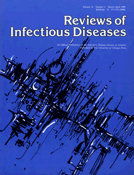-
Views
-
Cite
Cite
Dennis L. Stevens, Daniel M. Musher, David A. Watson, Hugh Eddy, Richard J. Hamill, Ferenc Gyorkey, Henry Rosen, Jon Mader, Spontaneous, Nontraumatic Gangrene Due to Clostridium septicum, Reviews of Infectious Diseases, Volume 12, Issue 2, March-April 1990, Pages 286–296, https://doi.org/10.1093/clinids/12.2.286
Close - Share Icon Share
Abstract
Costridium septicum is a major cause of spontaneous, nontraumatic gas gangrene. Unlike Clostridium perfringens, C. septicum is relatively aerotolerant and thus appears to be more capable of initiating infection in the absence of obvious damage to tissues. Six cases illustrate the clinical setting and fulminant nature of spontaneous gangrene caused by C. septicum. A lesion in the colon such as carcinoma is often present and is presumed to serve as a portal of entry to the bloodstream. Diabetes and leukopenia are also common predisposing conditions; compromise of vital host responses may facilitate proliferation of those organisms that settle out in the tissues. Acute lymphoma or leukemia during a course of chemotherapy is accompanied by damage to bowel mucosa and granulocytopenia, thus predisposing to spontaneous clostridial gangrene. Infection progresses in a fulminating manner; the majority of patients die within 24 hours of onset. Characteristic symptoms and signs include excruciating pain (although a sense of heaviness may be the only early symptom), swelling of tissues, crepitance, and bulla formation. A hallmark of C. septicum infection is the absence of acute inflammatory cells in involved tissues or in bulla fluid. A series of laboratory investigations demonstrated that fluid obtained from a bulla adversely affected the viability, morphology, and function of polymorphonuclear leukocytes (PMNs), which may explain the paucity of PMNs in involved tissues and may in part contribute to the fulminant progression observed in infection due to this organism.
- inflammatory cells
- diabetes mellitus
- edema
- diabetes mellitus, type 2
- immune response
- carcinoma
- chemotherapy regimen
- clostridium
- death
- gangrene
- gas gangrene
- intestines
- leukemia
- leukopenia
- lymphoma
- neutrophils
- pain
- infections
- agranulocytosis
- blister
- colon
- mucous membrane
- clostridium septicum
- symptom onset







Comments